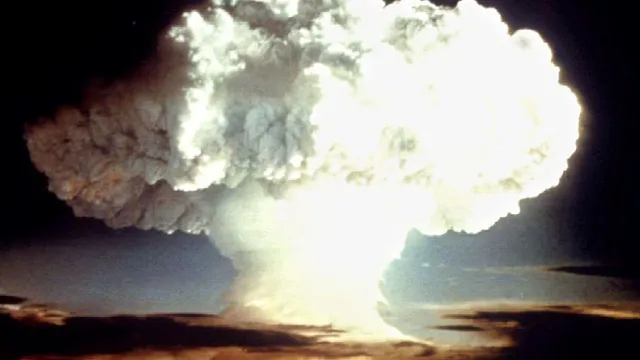- By Ajeet Kumar
- Fri, 31 Oct 2025 02:07 PM (IST)
- Source:JND
US President Donald Trump has instructed the Pentagon to resume nuclear weapons testing immediately, “on an equal basis” with other countries' testing programs. If Trump is referring to the resumption of explosive nuclear testing, this would be an extremely unfortunate, regrettable step by the United States.
It would almost inevitably be followed by tit-for-tat reciprocal announcements by other nuclear-armed states, particularly Russia and China, and cement an accelerating arms race that puts us all in great jeopardy.
Why are nuclear tests risky
It would also create profound risks of radioactive fallout globally. Even if such nuclear tests are conducted underground, this poses a risk in terms of the possible release and venting of radioactive materials, as well as the potential leakage into groundwater.
The Comprehensive Nuclear Test Ban Treaty has been signed by 187 states – it's one of the most widely supported disarmament treaties in the world.
The US signed the treaty decades ago, but has yet to ratify it. Nonetheless, it is actually legally bound not to violate the spirit and purpose of the treaty while it's a signatory.
What nuclear testing is used for
In earlier years, the purpose of testing was to understand the effects of nuclear weapons – for example, the blast damage at different distances, which provides confidence in destroying a given military target.
Understanding the consequences of nuclear weapons helps militaries plan their use and, to some extent, protect their own military equipment and people from the possible use of nuclear weapons by adversaries.
But since the end of the Second World War, states have mostly used testing as part of the development of new weapon designs. There have been a very large number of tests, more than 2,000, mostly seeking to understand how these new weapons work.
ALSO READ: What Is 'Poseidon'? Russia’s Unique Nuclear Underwater Drone Capable Of Catastrophic Destruction
The huge environmental and health problems caused by nuclear testing prompted nations to agree on a moratorium on atmospheric testing for a couple of years in the early 1960s. In 1963, the Partial Test Ban Treaty banned nuclear tests in all environments except underground.
Since then, nuclear-armed states have stopped testing at different times. The US stopped in 1992, while France stopped in 1996. China and Russia also aren't known to have conducted any tests since the 1990s.
North Korea is the only state to have openly tested a nuclear weapon this century, most recently in 2017.
Why nuclear tests stopped
These stoppages came in the 1990s for a reason: by that time, it became possible to test new nuclear weapon designs reliably through technical and computer developments, without having to actually explode them.
So, essentially, the nuclear states, particularly the more advanced ones, stopped when they no longer needed to explosively test new weapon designs to keep modernising their stocks, as they're still doing.
Worrying levels of nuclear proliferation
There is some good news on the nuclear weapons front. The Treaty on the Prohibition of Nuclear Weapons has now been signed by half the world's nations. This is a historic treaty that, for the first time, bans nuclear weapons and provides the only internationally agreed framework for their eventual elimination.
With the exception of this significant development, however, everything else has been going badly.
What are big powers doing with their nuclear weapons?
The exact number of warheads each country has are secret but Russia has a total of about 5,459 warheads while the United States has about 5,177, according to the Federation of American Scientists, opens new tab. Those number include deployed, stockpiled and retired warheads.
The Washington DC-based Arms Control Association says the United States has a stockpile of 5,225 nuclear warheads and Russia has 5,580.
Global nuclear warhead stockpiles peaked in 1986 at over 70,000 warheads, most in the Soviet Union and the United States, but have since been reduced to about 12,000, most still in Russia and the United States.
China is the third largest nuclear power with 600 warheads, France has 290, the United Kingdom 225, India 180, Pakistan 170, Israel 90 and North Korea 50, according to the Federation of American Scientists
(With inputs from agencies)

